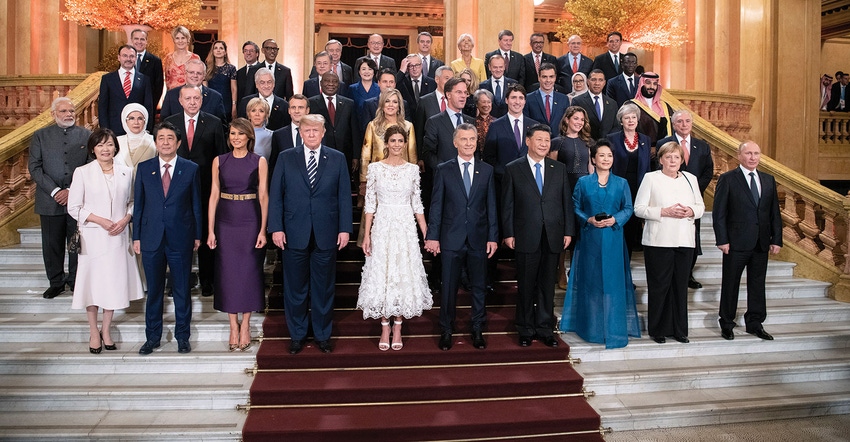
An “engineered” global slowdown is underway, weakening the near-term global demand for commodities. I do not expect a serious recession for several more years; what we are currently experiencing could be characterized as a controlled mini-recession or a corrective realignment.
These corrective realignments will appear periodically to deflate asset bubbles. The most obvious current category of assets showing overvaluation (bubble tendencies) are global equities.
Presently, governments and central banks are realigning global currency, bond, equity and commodity markets, so U.S. and global economic momentum can possibly be maintained for several years. The current ongoing realignment may last well into the second quarter of 2019.
Given the extended length of the U.S. business cycle (which is the second longest in U.S. history), global economic, political and policy uncertainties and market fundamentals, “world leaders” will define the market structure and character of the U.S. and global currency, bond, equity, and commodity markets in 2019.
Every market analyst and participant must continually consider the potential market impact of global governmental stimulus-driven intervention, while their peripheral market vision must always focus on activities of multinational firms, hedge funds and other speculators.
Questions
This raises several questions:
Q: Defining world leaders?
A: Global governmental and central bank leaders do the really heavy lifting, while multinational firms and major hedge funds and other speculators have interesting influence.
Q: Do world leaders champion a common cause?
A: Yes. It’s self-preservation or the maintenance of global economic momentum at all costs through fiscal, monetary, trade and regulatory stimulus policy activities both individually as countries and collectively to achieve and maintain a global growth level that avoids a recession.
A recession in today’s debt-burdened global economic setting, which chokes off economic momentum, could easily escalate into potentially a far worse economic or military outcome. Later we will discuss the self-serving predatory actions of some world leaders.
Stimulus-driven domestic and global growth has been the order of the day since the December 2007 recession began. Stimulus-driven global growth is a high maintenance activity requiring a great deal of ongoing attention to detail by global governments and central banks, in part because of the emergence of asset bubbles.
Asset bubbles
In today’s economic setting, asset bubbles are especially prevalent in U.S. and global equity markets, so as they emerge they must then be bled off — which is what we are experiencing today in the global equity markets.
World leaders all agree maintaining global growth at a level that sustains economic momentum — no matter the cost — is an absolute imperative. Once world leaders know that a near-term recession will likely be avoided, some then turn their attention to individual self-serving political, economic, and military goals.
This is the point where the ongoing fiscal, monetary, trade and regulatory policy disputes must be addressed. In other words, collective policy fairness requires ongoing negotiations like the recent G-20 meeting and one-on-one negotiations.
President Trump’s aggressive one-on-one negotiations with his counterparts around the world are highly unique in the world of global diplomacy.
The United States’ diplomatic policy negotiations led by President Trump with world leaders are designed to redefine fairness related to fiscal, monetary, trade and regulatory policy issues.
Timing of these policy negotiations is very important. With mid-term elections completed, a window of opportunity exists to hold bilateral and multilateral negotiations to redefine economic and other forms of fairness between countries. This window could extend into the middle of 2019.
National strategic plans
Do world leaders champion their own national strategic plan? The quick answer is yes. China and Russia are at the head of the self-serving list of global predators.
The president and Congress are focused on an array of fiscal, trade and regulatory issues, but none more important than viable economic growth and maintaining global technological, financial, and military supremacy.
Through monetary policy, the U.S. Federal Reserve Board complements the president and Congress by currently bleeding their balance sheet and continuing to raise interest rates to a level that avoids a fixed income crisis and prepares them for the next economic downturn.
China’s leadership has a simple and straight forward plan: First, maintain a critical level of sustainable growth; second, achieve global technological supremacy by 2025, financial supremacy by 2035 and military supremacy by 2047.
Globally today, who has technological supremacy, the United States or China? China’s objective is to have global technological supremacy by 2025 if not earlier. Any country or business having technological supremacy will dominate their competition.
Russian technological and military aggression will likely be rewarded by territorial expansion. It is not obvious that their ambition can be easily checked.
EU financial crisis
The European Union presently has a financial crisis — an entitlement and leadership crisis of historic proportions.
The list continues with Japan, Turkey, Saudi Arabia, Iran, etc.
What is the potential market impact over the next three to seven months?
• U.S. dollar likely will have more strength than weakness. Why? I still expect one to two Fed rate hikes in 2019.
• U.S. 10-Year Treasury yield sideways with a downside bias while global economic clouds on the horizon signal policy uncertainties remain.
• Global equities likely need to realign at lower levels to be in balance with the collective market space of currencies, bonds and commodities.
• Commodity prices are being punished by the ongoing global economic slowdown and accompanying collective market realignment, but -- to end on a positive note — they are building a base to capitalize on future growth.
The next three to seven months are a period for cautionary or conservative business practices, which will be followed by a throttle-up growth period and rising demand for commodities.
Dr. Bobby Coats is a professor in the Department of Agricultural Economics and Agribusiness, University of Arkansas System, Division of Agriculture, Cooperative Extension Service. He can be reached at [email protected]. This article was written for Farm Press.
DISCLAIMER-FOR-EDUCATIONAL-PURPOSES-ONLY
About the Author(s)
You May Also Like




